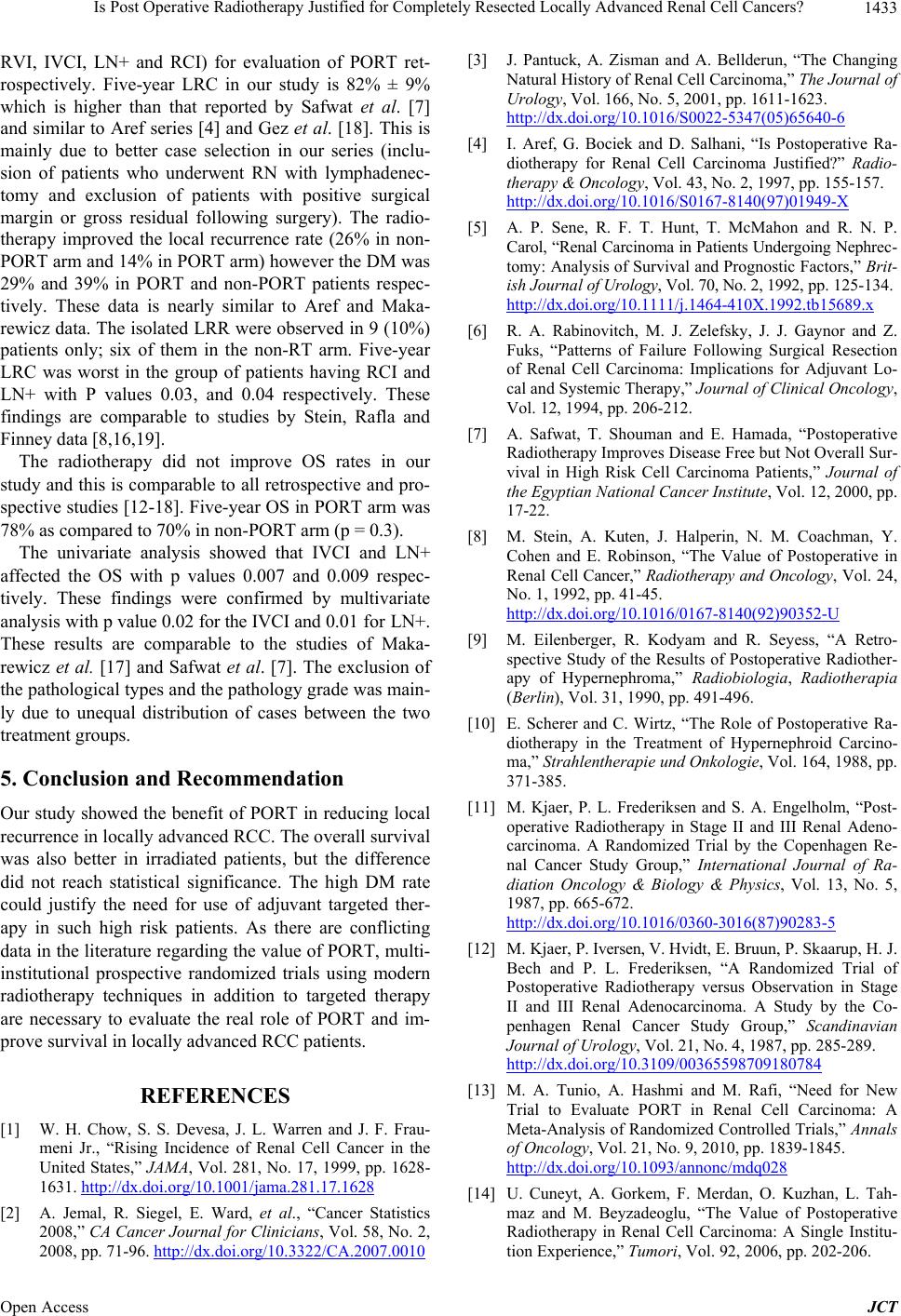
Is Post Operative Radiotherapy Justified for Completely Resected Locally Advanced Renal Cell Cancers? 1433
RVI, IVCI, LN+ and RCI) for evaluation of PORT ret-
rospectively. Five-year LRC in our study is 82% ± 9%
which is higher than that reported by Safwat et al. [7]
and similar to Aref series [4] and Gez et al. [18]. This is
mainly due to better case selection in our series (inclu-
sion of patients who underwent RN with lymphadenec-
tomy and exclusion of patients with positive surgical
margin or gross residual following surgery). The radio-
therapy improved the local recurrence rate (26% in non-
PORT arm and 14% in PORT arm) however the DM was
29% and 39% in PORT and non-PORT patients respec-
tively. These data is nearly similar to Aref and Maka-
rewicz data. The isolated LRR were observed in 9 (10%)
patients only; six of them in the non-RT arm. Five-year
LRC was worst in the group of patients having RCI and
LN+ with P values 0.03, and 0.04 respectively. These
findings are comparable to studies by Stein, Rafla and
Finney data [8,16,19].
The radiotherapy did not improve OS rates in our
study and this is comparable to all retrospective and pro-
spective studies [12-18]. Five-year OS in PORT arm was
78% as compared to 70% in non-PORT arm (p = 0.3).
The univariate analysis showed that IVCI and LN+
affected the OS with p values 0.007 and 0.009 respec-
tively. These findings were confirmed by multivariate
analysis with p value 0.02 for the IVCI and 0.01 for LN+.
These results are comparable to the studies of Maka-
rewicz et al. [17] and Safwat et al. [7]. The exclusion of
the pathological types and the pathology grade was main-
ly due to unequal distribution of cases between the two
treatment groups.
5. Conclusion and Recommendation
Our study showed the benefit of PORT in reducing local
recurrence in locally advanced RCC. The overall survival
was also better in irradiated patients, but the difference
did not reach statistical significance. The high DM rate
could justify the need for use of adjuvant targeted ther-
apy in such high risk patients. As there are conflicting
data in the literature regarding the value of PORT, multi-
institutional prospective randomized trials using modern
radiotherapy techniques in addition to targeted therapy
are necessary to evaluate the real role of PORT and im-
prove survival in locally advanced RCC patients.
REFERENCES
[1] W. H. Chow, S. S. Devesa, J. L. Warren and J. F. Frau-
meni Jr., “Rising Incidence of Renal Cell Cancer in the
United States,” JAMA, Vol. 281, No. 17, 1999, pp. 1628-
1631. http://dx.doi.org/10.1001/jama.281.17.1628
[2] A. Jemal, R. Siegel, E. Ward, et al., “Cancer Statistics
2008,” CA Cancer Journal for Clinicians, Vol. 58, No. 2,
2008, pp. 71-96. http://dx.doi.org/10.3322/CA.2007.0010
[3] J. Pantuck, A. Zisman and A. Bellderun, “The Changing
Natural History of Renal Cell Carcinoma,” The Journal of
Urology, Vol. 166, No. 5, 2001, pp. 1611-1623.
http://dx.doi.org/10.1016/S0022-5347(05)65640-6
[4] I. Aref, G. Bociek and D. Salhani, “Is Postoperative Ra-
diotherapy for Renal Cell Carcinoma Justified?” Radio-
therapy & Oncology, Vol. 43, No. 2, 1997, pp. 155-157.
http://dx.doi.org/10.1016/S0167-8140(97)01949-X
[5] A. P. Sene, R. F. T. Hunt, T. McMahon and R. N. P.
Carol, “Renal Carcinoma in Patients Undergoing Nephrec-
tomy: Analysis of Survival and Prognostic Factors,” Brit-
ish Journal of Urology, Vol. 70, No. 2, 1992, pp. 125-134.
http://dx.doi.org/10.1111/j.1464-410X.1992.tb15689.x
[6] R. A. Rabinovitch, M. J. Zelefsky, J. J. Gaynor and Z.
Fuks, “Patterns of Failure Following Surgical Resection
of Renal Cell Carcinoma: Implications for Adjuvant Lo-
cal and Systemic Therapy,” Journal of Clinical Oncology,
Vol. 12, 1994, pp. 206-212.
[7] A. Safwat, T. Shouman and E. Hamada, “Postoperative
Radiotherapy Improves Disease Free but Not Overall Sur-
vival in High Risk Cell Carcinoma Patients,” Journal of
the Egyptian National Cancer Institute, Vol. 12, 2000, pp.
17-22.
[8] M. Stein, A. Kuten, J. Halperin, N. M. Coachman, Y.
Cohen and E. Robinson, “The Value of Postoperative in
Renal Cell Cancer,” Radiotherapy and Oncology, Vol. 24,
No. 1, 1992, pp. 41-45.
http://dx.doi.org/10.1016/0167-8140(92)90352-U
[9] M. Eilenberger, R. Kodyam and R. Seyess, “A Retro-
spective Study of the Results of Postoperative Radiother-
apy of Hypernephroma,” Radiobiologia, Radiotherapia
(Berlin), Vol. 31, 1990, pp. 491-496.
[10] E. Scherer and C. Wirtz, “The Role of Postoperative Ra-
diotherapy in the Treatment of Hypernephroid Carcino-
ma,” Strahlentherapie und Onkologie, Vol. 164, 1988, pp.
371-385.
[11] M. Kjaer, P. L. Frederiksen and S. A. Engelholm, “Post-
operative Radiotherapy in Stage II and III Renal Adeno-
carcinoma. A Randomized Trial by the Copenhagen Re-
nal Cancer Study Group,” International Journal of Ra-
diation Oncology & Biology & Physics, Vol. 13, No. 5,
1987, pp. 665-672.
http://dx.doi.org/10.1016/0360-3016(87)90283-5
[12] M. Kjaer, P. Iversen, V. Hvidt, E. Bruun, P. Skaarup, H. J.
Bech and P. L. Frederiksen, “A Randomized Trial of
Postoperative Radiotherapy versus Observation in Stage
II and III Renal Adenocarcinoma. A Study by the Co-
penhagen Renal Cancer Study Group,” Scandinavian
Journal of Urology, Vol. 21, No. 4, 1987, pp. 285-289.
http://dx.doi.org/10.3109/00365598709180784
[13] M. A. Tunio, A. Hashmi and M. Rafi, “Need for New
Trial to Evaluate PORT in Renal Cell Carcinoma: A
Meta-Analysis of Randomized Controlled Trials,” Annals
of Oncology, Vol. 21, No. 9, 2010, pp. 1839-1845.
http://dx.doi.org/10.1093/annonc/mdq028
[14] U. Cuneyt, A. Gorkem, F. Merdan, O. Kuzhan, L. Tah-
maz and M. Beyzadeoglu, “The Value of Postoperative
Radiotherapy in Renal Cell Carcinoma: A Single Institu-
tion Experience,” Tumori, Vol. 92, 2006, pp. 202-206.
Open Access JCT